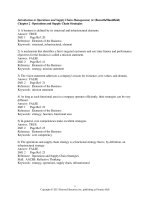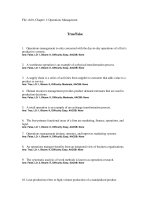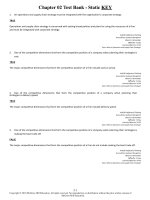Lecture Operations and supply chain management: The Core (3/e) – Chapter 4: Strategic capacity management
Bạn đang xem bản rút gọn của tài liệu. Xem và tải ngay bản đầy đủ của tài liệu tại đây (783.15 KB, 14 trang )
Strategic Capacity
Management
Chapter 04
McGrawHill/Irwin
Copyright © 2013 by The McGrawHill Companies, Inc. All rights reserved.
Learning Objectives
1.
2.
3.
4.
Understand the concept of capacity and how
important it is to “manage” capacity.
Explain the impact of economies of scale of a
firm.
Understand how to use decision trees to
analyze alternatives when faced with the
problem of adding capacity.
Describe the differences in planning capacity
between manufacturing firms and service
firms.
42
Capacity Management in
Operations
Capacity – the ability to hold, receive, store, or
accommodate
In business, viewed as the amount of output
that a system is capable of achieving over a
specific period of time
Capacity management needs to consider both
inputs and outputs
43
Capacity Planning Time
Durations
44
Capacity Planning Concepts
45
Capacity Planning Concepts
Capacity Focus – the idea that a production
facility works best when it is concentrated on a
limited set of production objectives
Focused factory or plant within a plant (PWP)
concept
Capacity Flexibility – the ability to rapidly
increase or decrease product levels or the
ability to shift rapidly from one product or
service to another
Flexibility comes from the plant, processes, and
workers or from strategies that use the capacity of
other organizations
46
Capacity Flexibility
47
Considerations in Changing
Capacity
48
Determining Capacity
Requirements
Excel: Capacity Requirements
49
Determining Capacity
Requirements
Step 3: Project equipment and
labor availabilities
Percentage capacity
utilized
Plastic
Bag
Machine requirement
Operation
Labor requirement
Percentage capacity
utilized
Bottle
Operation Machine requirement
Labor requirement
Ye ar
1
2
3
4
5
24
48
72
84
94
1.2
2.4
3.6
4.2
4.7
3.6
7.2
10.8
12.6
14.1
30
41
54
66
77
0.9
1.23
1.62
1.98
2.31
1.8
2.46
3.24
3.96
4.62
Excel: Components of Deman
410
Decision Trees for Capacity
Analysis
A decision tree is a schematic model of the
sequence of steps in a problem – including the
conditions and consequences of each step
Decision trees help analysts understand the
problem and assist in identifying the best
solution
Decision tree components
Decision nodes – represented with squares
Chance nodes – represented with circles
Paths– links between nodes
411
Planning Service Capacity
412
Capacity Utilization and Service
Quality
The relationship between service capacity
utilization and service quality is critical
Utilization is measured by the portion of time
servers are busy
Optimal levels of utilization are context specific
Low rates are appropriate when the degree of
uncertainty (in demand) is high and/or the stakes
are high (e.g. emergency rooms, fire
departments)
Higher rates are possible for predictable services
or those without extensive customer contact (e.g.
commuter trains, postal sorting)
413
Service Quality
Rate of service utilization and service quality
Service quality
are directly linked
declines – disruptions
Arrivals exceed
services – many
customers are never
served
or high arrival levels
lead to long wait times
Sufficient capacity to
provide quality service
414









